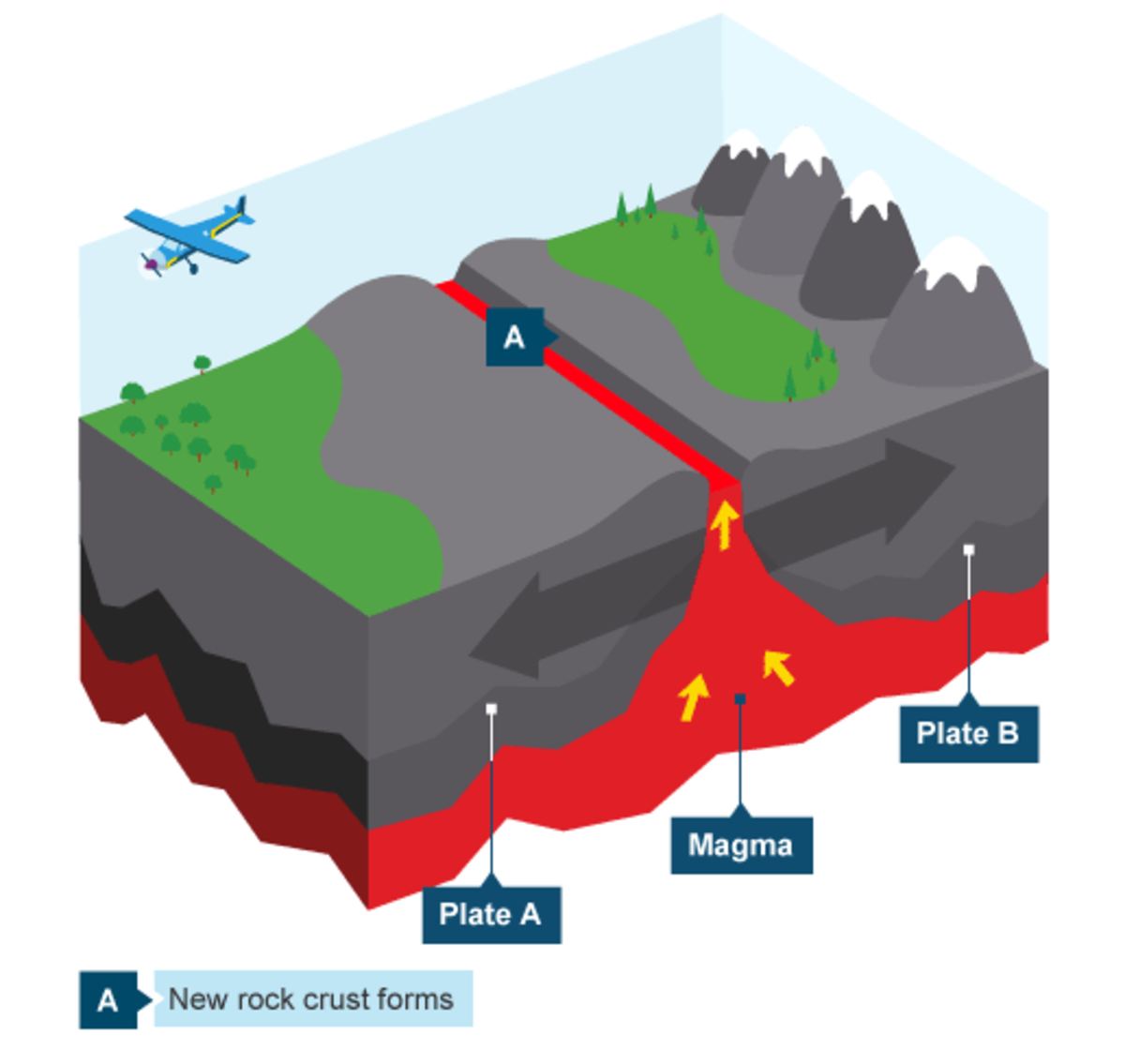
divergent boundary
A divergent boundary occurs when two tectonic plates move away from each other. Along these boundaries, earthquakes are common and magma (molten rock) rises from the Earth's mantle to the surface, solidifying to create new oceanic crust. The Mid-Atlantic Ridge is an example of divergent plate boundaries.

Labeled Divergent Plate Boundary Diagram
A convergent plate boundary also known as a destructive plate boundary , usually involves an oceanic plate and a continental plate. The plates move towards one another and this movement.

Divergent Boundary Easy Science Divergent boundary, Plate tectonics, Easy science
Spreading Centers along Divergent Plate Boundaries. A spreading center is a linear area where new crust forms where two crustal plates are moving apart, such as along a mid-oceanic ridge. Spreading centers are typically seismically active regions in ocean basins and may be regions of active or frequent volcanism (Figure 4.7).
/GettyImages-483766933-56c6e7fd3df78cfb37869a63.jpg)
Divergent Boundaries
A divergent plate boundary often forms a mountain chain known as a ridge. This feature forms as magma escapes into the space between the spreading tectonic plates.

Divergent Boundary Definition & Examples Video & Lesson Transcript
Key points: Earth's lithosphere, or outermost shell, is broken up into large pieces called tectonic plates. These plates move slowly over the asthenosphere, a layer of softer rock below the lithosphere. On average, tectonic plates move a few centimeters per year. The place where two plates meet is called a plate boundary.

Divergent boundary Wikipedia
Facts About the Divergent Plate Boundary Explained with a Diagram Divergent plate boundaries are those tectonic borders where tectonic plates pull away from each other and form a new crust. ScienceStruck takes you through some interesting facts about these divergent boundary zones on this Earth.

Divergent plate boundary zenhac
Plate Tectonics Series: Drawing & annotating a diagram of a divergent plate boundary. Featuring the ridge, lithospheric plate composition, density and asthen.

Plate Tectonics September 2012
In the oceans, plates move apart at mid-ocean ridges. Lava rises upward, erupts, and cools. Later, more lava erupts and pushes the original seafloor outward. This is seafloor spreading. Seafloor spreading forms new oceanic crust. The rising magma causes the ridge to be buoyant. This is why there are mountain ranges running through the oceans.

Evolution of the Theory of Plate Tectonics Owlcation
4.5 Divergent Plate Boundaries Modified from "Physical Geology" by Steven Earle* Divergent boundaries are spreading boundaries, where new oceanic crust is created to fill in the space as the plates move apart. Most divergent boundaries are located along mid-ocean oceanic ridges (although some are on land). The mid-ocean ridge

Labeled Divergent Plate Boundary Diagram
Lesson 1: Plate tectonics Plate tectonics: Difference between crust and lithosphere Structure of the earth Plate tectonics: Evidence of plate movement Plate tectonics: Geological features of divergent plate boundaries Plate tectonics: Geological features of convergent plate boundaries Plates moving due to convection in mantle
Divergent plate boundary Labelled diagram
Divergent plate boundaries are locations where plates are moving away from one another. This occurs above rising convection currents. The rising current pushes up on the bottom of the lithosphere, lifting it and flowing laterally beneath it. This lateral flow causes the plate material above to be dragged along in the direction of flow.

divergent Boundary
In plate tectonics, a divergent boundary or divergent plate boundary (also known as a constructive boundary or an extensional boundary) is a linear feature that exists between two tectonic plates that are moving away from each other. Divergent boundaries within continents initially produce rifts, which eventually become rift valleys.

A divergent boundary happens when two plates spread apart...
Most divergent boundaries are located along mid-ocean oceanic ridges (although some are on land). The mid-ocean ridge system is a giant undersea mountain range, and is the largest geological feature on Earth; at 65,000 km long and about 1000 km wide, it covers 23% of Earth's surface (Figure 4.5.1 4.5. 1 ). Because the new crust formed at the.

Tectonic Plate Margins HubPages
Updated on January 17, 2020 Divergent boundaries exist where tectonic plates move apart from each other. Unlike convergent boundaries, divergence occurs between only oceanic or only continental plates, not one of each.

Pin on Earth Science
Divergent (Spreading) :This is where two plates move away from each other. Molten rock from the mantle erupts along the opening, forming new crust. The earthquakes that occur along these zones, called spreading centers, are relatively small.

Divergent Plate Boundaries Geology (U.S. National Park Service)
In the western part of the continent, divergent plate boundary forces are beginning to rip the continent apart, forming the Basin and Range Province and its adjacent eastern arm, known as the Rio Grande Rift. National Park Service sites in this region showcase block-fault mountains and volcanic features forming as the thick crust stretches and.